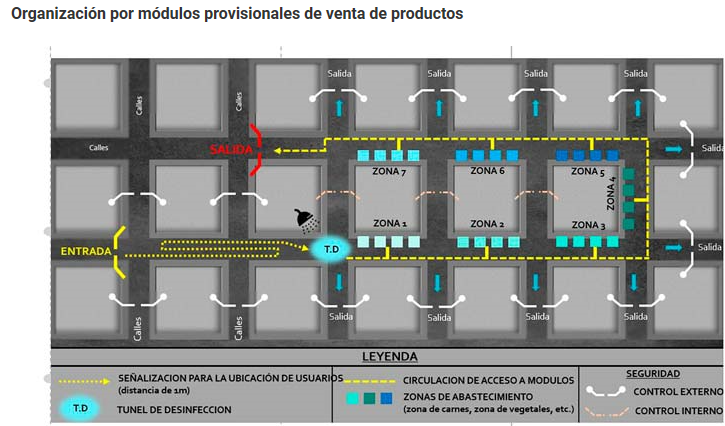After a period of confinement many cities in Latin America begin to reactivate and enter what is called in many places the “new normality”. This new normality is accompanied by many measures and devices that serve to avoid two fundamental issues: agglomerations and displacement.
One of the activities that usually involves agglomeration and displacement is having to go to buy food in the food markets. These supply markets are one of the municipalities’ concerns since the most acute moments of the pandemic. That is why many municipalities implemented measures and responses to address this situation.
Many of these short-term responses have great potential to generate value and innovation, both economically and socially. But this potential generator of value and innovation is maximized if we manage to move from a conjunctural response to a permanent solution. The key factor is to develop them under a comprehensive strategy. In this way, these solutions become: tactical actions that are located within a sustainable strategic orientation. And here we are already talking about: “tactical urbanism”.
In this perspective I want to develop in this article 5 proposals that have been defined in different contexts, but all under the same logic: avoid agglomerations in the markets and limit displacements:
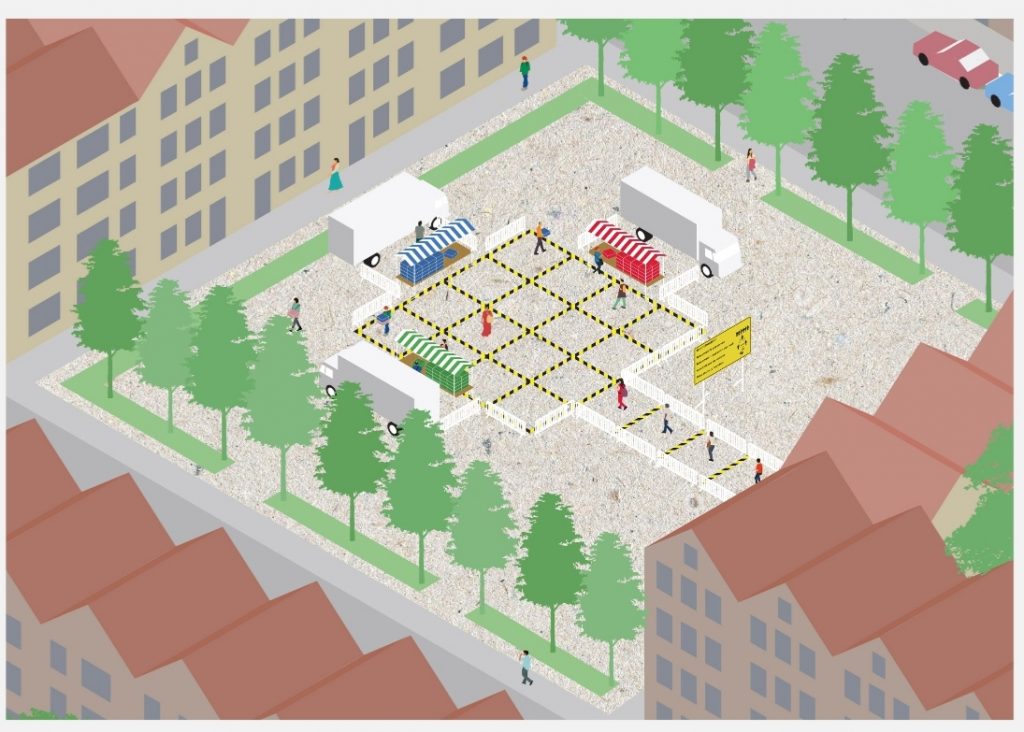
The first proposal is called “Micro Hyper Localized Markets”, and has been developed by the architecture and urban planning agency Shift of the city of Rotterdam. The proposal is to use public places or spaces to offer fresh food for sale, and sometimes essential products. Through a line of 16 grids that make up a large square, stands are established on 3 sides (1 for each side). Each of these stalls has a space where the user requests the product and another where he recovers it and pays for it.
The fourth side of the square is used as the only access point. Only a maximum of 6 people are allowed inside the square, the other users must make a queue before being able to enter, keeping the recommended distance. There are 2 exit points that facilitate circulation and minimize contact.
The versatility of this proposal allows the model to be implemented in different squares (and public spaces of the neighborhood), and replicate the facilities in different parts of the city. This experience was implemented during the period of confinement in the Netherlands and was very well received, especially by those who couldn’t go to supermarkets and who had as their only point of access to these products in these open spaces.
The second proposal I want to present to you is called “Temporary Linear Supply Centers” and has been proposed jointly by the Colegio de Arquitectos del Perú and the Universidad de Ciencias y Artes de América Latina – UCAL. Rudolf Giese, Director of the Faculty of Architecture of the UCAL presented this proposition in an interview of a local newspaper (Perú21), from which I have taken the following images to present this proposal.
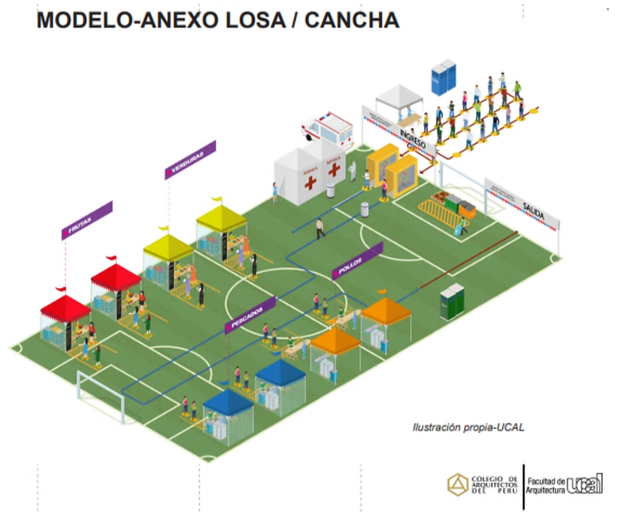
Using a linear modular pattern as we can see, the yellow line represents the circuit to follow from the entrance, passing through a disinfection zone and following a circuit of blocks where vehicles are parked on one side of the street where the traders are established by different categories (represented in blue). In this proposal there is only one entry, and multiple outputs (indicated by the white lines).
This proposal has variations according to the area available: for example, sports spaces (using the edges to set up stands); it can also be in parks (placing stands at the edges), corners or street crossings, and also the avenues. All these variations follow the same linear pattern with a single access, disinfection zone, internal circuit and multiple outputs.
The third proposal is called “City Fairs” and has been launched by the Municipality of Buenos Aires. Following a model from which they are derived; the Municipal Fairs.
These fairs of the city consist of the “widening” of the sidewalks, placing modular modules on one side of the street, where only fresh food is offered. Users are located at a certain distance from the vendors, to whom they deliver their bags and shopping carts so that the sellers can place the requested products inside. The payment and collection of the products is done in a small cabin adapted to reduce the contact.
For this system works, it is necessary to have wide streets that allow the circulation of users and eventually of vehicles.
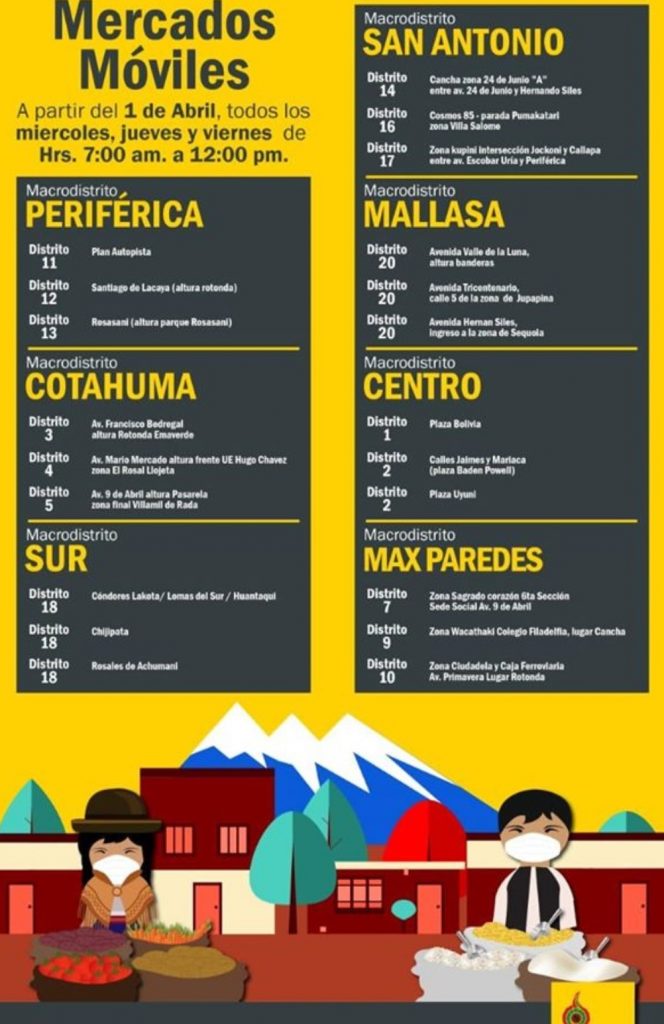
The fourth proposal is called: “Mobile Markets of the City of La Paz”. The mobile markets are distributed in the 7 macro districts of the city (at the rate of 4 districts per day). A fleet of lorries takes industrial producers and traders to districts further away from traditional supply centers.
The Municipality organizes the producers and coordinates with the sub-municipalities, the dates and opening times of each district. A particularity of this model is the complementarity in the supply of products, as there are; both food and industrial products.
The Municipality of La Paz is currently analyzing the possibility of integrating this practice into the municipal policy on urban centralities, evaluating the demand for the application of the system from users as well as producers.
The fifth proposal I would like to present to you, entitled ‘Distribution Centers for Light Mobility’, is a proposal of my own, which I have drawn up. The proposal is to reorganize a service that already exists and is provided by a sort of “Arabbers” in tricycles: the street vendors of fruits and vegetables in the city. It is a recurring character in most Latin American cities.
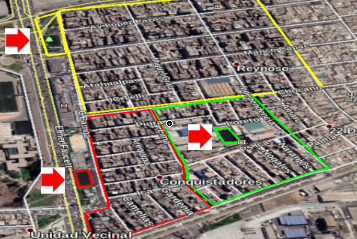
To illustrate my proposal I have taken a sector of the district of Carmen de la Legua in Peru. I have divided this area (arbitrarily) into 3 sectors, marked with the colors yellow, green and red. In each of these sectors I have identified a space as storage points for food products, in this case the chosen points are sports grounds. From these storage points, daily and in a cadential way fleets or squadrons of tricycles would leave to distribute/offer the products to the houses, for this they would follow previously established routes. When they finish distributing the products, they can go back to the storage center to recharge their unit and get out again.
This method mainly offers to bring the products to the homes, in an orderly and predictable way, because being a route defined and assigned to a seller, the users can know the seller and the schedules of their journey. Shops in the neighborhood could join as partners in a progressive way fulfilling different roles; for example, as link points, or as pick-up and distribution points of packages when users are not there, for some reason at their homes during the schedules of service.
This proposal requires a high degree of engagement (from the municipality) because distribution, circuits and vendors have to be organized. The potential it has is quite high not only to provide a service to the neighbors, but also to assure economic income to the commercial sector in an innovative way. It also makes it possible to strengthen the associative tissue and perform a very low CO2 emission practice. All these points make this initiative economically, socially and environmentally sustainable.
Finally, in order for these 5 proposals for tactical planning to be a lever of innovation, a strategy based on three pillars is required:
The first is the local government leadership. I know that there is a level of leadership from the private sector or that there are many initiatives from the associative sector: NGO’s, universities and even churches, But in this case a direct engagement of the public authority is required because many coordination actions have to be carried out, as well as many regulatory actions (of prices, weights, working conditions,…). These are multiple dimensions that only the public authorities can ensure compliance with.
The second pillar is that this service must be implemented as a network service. In order to be economically sustainable, it is absolutely necessary that the service be implemented through a network of actors, which will ensure a fluidity and continuity in supply and distribution and at the same time manage among all the externalities that this type of activity can generate.
The third pillar is that it must be seen as a comprehensive solution. Because the problem must be addressed in a multidimensional manner and by concentrating action in various areas: health, hygiene, trade, urban reorganization, mobility, safety, living standards, and many other elements of this new normality.
If you require more information on these proposals, feel free to write me in the comments section and I will be happy to respond.


